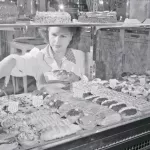When Did People Start Eating Sweets for Dessert?

Most of us don’t give a whole lot of thought to the habit of finishing a satisfying meal with a dessert of something sweet — we’re too busy savoring the delectable mouthfuls of cake, custard, or ice cream.
Yet this is a clear culinary tradition that many people follow. While some may elect to eat sweets before a main course, and others simply dig into pie or brownies at any time of the day, most adhere to the standard operating procedure of dessert after the main course at lunch or dinner. But how and when did this order come about? Why do we eat sweets after a savory meal, and not the other way around?
Humans Evolved To Have a Need for Sweets
To start somewhere close to the beginning, the craving for sweets is biological. Our hominid ancestors realized they derived more energy from ripe fruit with a higher sugar content than unripe fruit, and humans evolved with a hardwiring that connected sweetness to pleasurable feelings.
This primal need perhaps explains why sweets have traditionally featured into religious ceremonies for many cultures. As described in Michael Krondl’s Sweet Invention: A History of Dessert, Mesopotamian cooks prepared cakes as an offering to the goddess Ishtar. Similarly, Hindus throughout India have presented a sugar and milk concoction known as pedha to deities such as Kali for more than two millennia.
At times, the ritual of serving sweet dishes at distinct intervals has translated to something similar to the modern idea of dessert. After a day of fasting in celebration of Krishna’s birthday, Hindus traditionally indulge in treats such as bhog kheer, a pudding, or shrikhand, a sugar-flavored yogurt. In Turkey, the end of fasting at Ramadan means an opportunity for celebrants to sink their teeth into baklava, a beloved pastry.
Of course, the preparation and consumption of sweets has long been a part of secular mealtimes as well. The Deipnosophists, a work from the third-century Greek writer Athenaeus of Naucratis, describes an array of honey-coated fare served over a series of lavish banquets. However, the now-commonplace notion of specifically relegating such sweeter foods to the end of a meal has its origins in France.
Diners in Medieval France Enjoyed Meal-Ending Sweets
According to Sweet Invention, the term "dessert" appears in French cookbooks as far back as the 14th century; the French loanword is the noun form of the verb desservir, meaning "to remove what has been served." In the Late Middle Ages, dessert was distributed after the dishes of the main meal had been cleared, although these edibles weren't necessarily of the sweet variety.
The serving that followed dessert and concluded the meal, known as the issue, was more likely to consist of sweet foods such as fruit or spiced candies. Both the dessert and issue fell under the category of entremets, smaller portions that appeared between or after the main courses.
For European diners of the Late Middle Ages, it was common to see dishes of meat and cakes served together as the main course; there was little attempt to separate these foods of radically different tastes and textures. This remained the case even after sugar became more widely available on the continent, and influential Renaissance-era Italian cooks began showering all varieties of meals with healthy doses of the valuable commodity.
Desserts Emerged as a Distinct Course in the 17th Century
By the 17th century, there was a growing distinction between sweet and savory courses among French culinary practitioners, and with it arrived the modern notion for the proper way to end a meal. Dessert even earned an entry in the 1690 edition of the Dictionnaire Universel, defined as "the last course placed on the table... Dessert is composed of fruits, pastry, confectionery, cheese, etc."
Recipe books of the era also devoted increasing quantities of print to instructions for pastries, jams, and fruit dishes. However, the preparation of these meal-ending foods fell under a different jurisdiction than that of the chefs in charge of the main courses. Desserts were handled by confectioners who worked in the kitchen’s "office," or pantry.
Although the office initially was considered a subordinate branch of the kitchen pecking order, its confectioners came to be considered artisans in their own right thanks to the sculptural desserts served at the ostentatious dinners of King Louis XIV and other royals. Dessert as an art form arguably reached its peak in the early 19th century with the creations of French chef Antonin Carême, who built massive replications of pyramids, temples, and fountains out of sugar mixtures.
The French Revolution Led to Modern Dining Customs
The guidelines for dessert were changing even as Carême was producing his classically inspired pièces montées. The fall of the ruling class with the French Revolution meant that the chefs who once toiled in palace kitchens became unemployed. While some were able to find wealthy benefactors, others spurred the transformation of the public dining house by launching new eateries around Paris.
These restaurants introduced the concept of service à la russe, in which each customer ordered individual dishes to his or her liking, delivered one course at a time. Meanwhile, the rise of cafés and tea houses throughout the city further popularized the concept of single-portioned desserts.
By the arrival of the 20th century, the habit of dessert to polish off a meal, whether at home or a restaurant, had taken root in the country. And given France's powerful influence on culinary customs, it wasn't long before this sweet finishing touch at mealtime became standard across the rest of Europe, as well as on the other side of the Atlantic.
